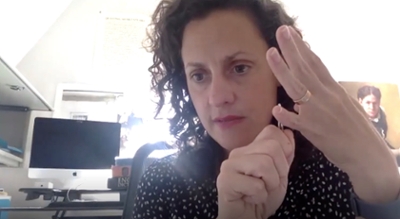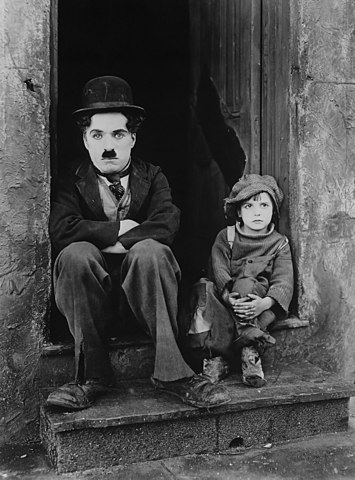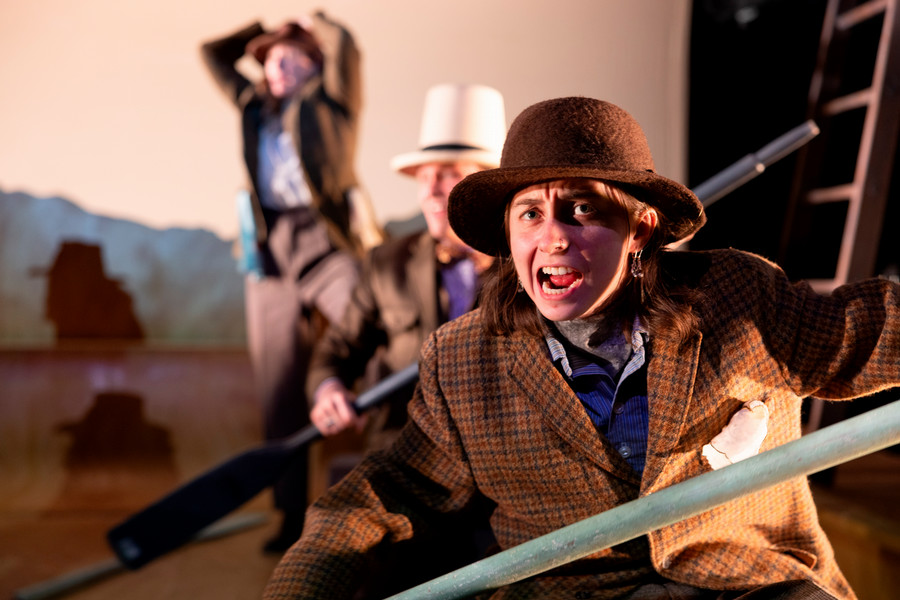Online Teaching: Acting for the Camera
By Tom PorterBowdoin News is publishing a series of stories about online classes, offering a glimpse into how faculty, staff, and students are adapting to the challenges of teaching and learning during a pandemic.

The move to remote learning has created the perfect opportunity for theater professor Abigail Killeen to introduce a new class. Acting for the Camera, which is cross-listed with cinema studies, encourages students to take full advantages of the different performance spaces they find themselves in.
Performing in front of a camera is similar to acting on stage, said Killeen, while also being very different. “On film, the viewer always has the experience of the work after the actor has completed it, as opposed to the theater, where the audience and the actor are having the experience simultaneously—and this is a very important distinction,” she explained. “The goal of all acting is always to release self-consciousness in favor of deep presence, but each medium invites different paths.”
Acting for the Camera (THTR 1151/CINE 1151) introduces students to the intellectual, vocal, physical, and emotional challenge of the acting process, distilled for on-camera work. The class meets synchronously once a week, has a hefty reading and viewing list, and is perfectly suited for the online teaching model imposed by the COVID-19 pandemic, said Killeen. “The students complete their acting assignments individually and upload their work for the rest of the class to digest in their own time and provide feedback during our synchronous sessions.” Students also learn the language of the screenplay and how to analyze it for acting clues, explained Killeen, learning, developing, and deploying new techniques that help translate that analysis into embodied performance.
“On film, the viewer always has the experience of the work after the actor has completed it, as opposed to the theater, where the audience and the actor are having the experience simultaneously."
“What you need to make performance is space and time,” said Killeen, “so, as the students meet in real time once a week, they are doing so from their own performance spaces, which are all different. All the things in your space,” she explained, “whether it’s a dog barking, a TV in the next room, an apron hanging on the wall behind you, they all become part of the story before you even open your mouth.”

“This course does not feel like a Frankenstein class,” said Carl Williams '23. “By that, I mean that it doesn’t feel like an in-person class that is now being all of a sudden taught remotely. Instead, it feels like a class that was meant to be taught virtually. I feel like in the context of remote learning the course is a perfect way to learn acting.” So far, he said, students have spent time filming themselves and attempting to break past any negative views they have of themselves. “I think understanding the emotions that we feel as we act and the emotions we feel as we watch film is at the core of Professor Killeen’s style. I appreciate her approach and have felt encouraged to show my identity through the work we do this semester,” he added.
“Acting for the Camera is a class that I've been thinking about for a while,” said Killeen. “It’s also an area of my own work that has grown in the past couple of years, as more film and television roles have come my way, and I’d like to pass on what I’ve learned.” The class will be a mix of performance and written work, while the syllabus includes the required viewing of movies such as the 1921 Charlie Chaplin silent classic The Kid and Barry Jenkins’s Oscar-winning Moonlight (2016).
The class’s first homework assignment includes an observation exercise in which they film themselves doing something—it can be anything—for sixty seconds, and then go back and view it. Then they need to write something about the experience of watching oneself on film. If it’s a horrible experience, Killeen encourages her students to do it again until they’re comfortable with what they see.

Throughout the course, students will be considering the issue of race and racism in film, and the extent to which damaging ideas are perpetuated in the media we consume, said Killeen. “As we open our eyes to the reality of the harm of our culture, we can also open our eyes to the choices we have within it,” she added. “One of the aims of the class is to strengthen and grow our awareness toward ‘a more equitable and just future,’” she said, quoting from the Bowdoin Department of Theater and Dance’s Black Lives Matter statement. The course includes a semester-long representation project in which students are asked, among other things, to rewatch some of their favorite movies and TV shows, considering issues like racial bias and stereotypes.
“Values that we promote, like shared humanity, empathy, fully embodied wisdom, and the instincts we have from our bodies and how we integrate and utilize them, those are all things that we always study in class, but they seem even more heightened now,” observed Killeen. “We’re in a time of crisis, and the arts are especially important in times of crisis.”



